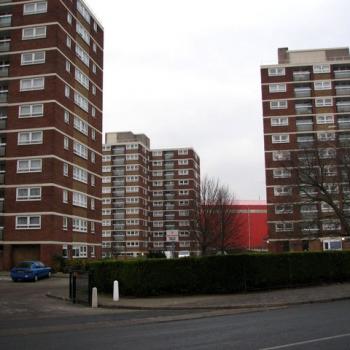![https://commons.wikimedia.org/wiki/File%3AWalkers_point_neighborhood_milwaukee.jpg; By Flickr user compujeramey [CC BY 2.0 (http://creativecommons.org/licenses/by/2.0)], via Wikimedia Commons](https://wp-media.patheos.com/blogs/sites/533/2018/01/Walkers_point_neighborhood_milwaukee-1024x683.jpg)
Or, “From the library: Evicted: Poverty and Profit in the American City, by Matthew Desmond.”
The book takes the form of a prologue with context, a long narrative telling the stories of the poor tenants of Milwaukee, and of their landlords, based on ethnographic fieldwork, and an epilogue with proposals. By “ethnographic fieldwork” I mean that the author, a Harvard professor, spent time living in a trailer park and in an inner city apartment, spending copious amounts of time with the individuals he profiled. He also spearheaded a detailed study of poor renters in Milwaukee. Oddly, the ethnographic research took place in 2008 – 2009, and tenant study from 2009 – 2011, but the book wasn’t published until 2016; maybe there’s an explanation that I’ve missed in the book, or maybe he just got delayed with the additional research and wasn’t able to complete it until he had more time available (he was, according to the book jacket, given a MacArthur “Genius” grant in 2015). Is the material invalid due to the delay in publication? I don’t know, but it seems likely that the initial post-recession time period might have been more extreme in the situations families faced.
In any case, any time we see the reports comparing the median rent to the income of low-income families, I’m always skeptical. “Of course, you can’t expect the lowest-decile workers to be able to afford median-priced rents; I’ll believe there’s a housing-cost crisis when you compare lowest-decile household incomes to lowest-decile rents.” But what Desmond reported is that the rents that the very poorest pay are not dramatically lower than everyone else’s, even though their apartments are generally (or often) in far worse condition, with broken or missing appliances, clogged sinks, leaking pipes, broken windows, and the like. They get the dregs of apartment buildings because of their conviction and eviction histories, lack of credit and work histories, and so on. Having multiple children makes apartment-hunting even harder, say, if a family is limited to two-bedroom units because of finances but they have more children than occupancy limits provide for, or if landlords simply don’t want children, or many children, in their buildings (regardless of the law on the matter).
And they are evicted frequently — partly because their extreme poverty means that they pay nearly all of their cash income (or welfare/SSI benefits) in rent; though food stamps cover their food costs, they have little left over for unexpected needs. (This also means that, in some instances, they sell food stamps to get cash, then get their food from food pantries until the next month comes.) They also get evicted after complaining about the condition of the apartment — either because the landlord accuses the tenant of being at fault for the claimed damage, like clogging the sink, or because the landlord decides to no longer let late rent slide after a complaint. And they get evicted in efforts to keep crime out of the units — whether the tenants are perpetrators (e.g., drug users), family members of druggies, or victims (e.g., of domestic abuse, with a boyfriend coming by and kicking down a door), or if there are police or ambulance calls for entirely unrelated reasons (e.g., an ambulance/fire visit for an asthmatic child). In some cases, they are compelled by the police to evict — presumably (though the book doesn’t state this) as an outcome of efforts to punish landlords for “harboring” criminals.
Desmond further profiles the difficulties the evictees have in trying to find new housing, as one woman calls 90-some-odd units before finding a landlord willing to take her on, in the meantime bouncing from one friend or relative or shelter to another, furniture and belongings in storage. Multiple generations squeeze into small apartments, sleeping on couches or on the floor. A woman turns tricks, leading johns into the bedroom and past the children in the living room.
Some of the individuals she profiles are addicted to drugs. Others receive SSI (due to mental health disabilities such as depression) or welfare. Some make their way with little more than food stamps and under the table work. One woman had a steady job at Old Country Buffet but spiraled into homelessness after having her hours cut. I don’t quite know what to make of the fact that none of the people Desmond profiles are the “working poor” whose paychecks, despite their steady jobs, aren’t enough to keep them stably-housed; maybe, no matter their troubles, they just aren’t as dramatic as these “worst-case” stories.
But what are Desmond’s solutions?
The first of these is simply to provide tenants with free attorneys to even their odds against landlords, who he believes make far more money than they “deserve.” He cites a program that provided such legal aid and prevented eviction in 86% of cases — though it’s not clear if 86% of all potential evictees won their cases, or if legal aid screened clients for their likelihood of success. His second proposal is far bigger: making housing vouchers as universally-available as food stamps are, with households qualifying solely based on income cut-offs. Call them “house stamps” — but instead of having the allotment based on the average cost of the “thrifty” meal plan, scaled to result in recipients hypothetically paying 30% of their income on food, the government would calculate a “fair” rent for a given apartment based on its particulars (presumably size, location, condition, and so forth), would calculate, for a given family, the level of apartment they are eligible for, and then require (as is already the case for Section 8 vouchers) that the recipient pay 30% of income, and the government would pay the rest. In order to ensure that enough apartments are available for recipients, the government would require all landlords to accept these vouchers, much as they already require that they comply with anti-discrimination laws.
So easy-peasy, right? Well, other than the cost, which he pegs at $22.5 billion, based on a 2013 study on housing vouchers for everyone below the 30th percentile in income. He proposes funding that by eliminating mortgage interest deductions and the capital-gains exclusion.
But Desmond assumes that landlords are making money hand-over-fist and these are somehow “excess” profits that can be easily removed. But if being a landlord was so immensely profitable and landlords are making far more money than they “deserve,” then you’d think that there would be far more landlords in the business, competing for the business of the poor and ultimately, by the greater number of available units, bringing quality up or prices down, or both. But how many landlords are there who want to deal with poor people, nagging them to pay up, dealing with unpaid rents, and with the crime that occurs, and the damage, whether intentional or the result of the chaotic lives of the poor (e.g., 8 people living in a home the plumbing of which was designed for a fraction of that number)?
To be sure, a part of the reason for the high rents, relative to the condition of the homes, and the difficulty the poor in having finding units, is their risk of nonpayment; having reliably-paying tenants would solve this part of the problem. But would the government manage to set the voucher amounts at the right level for prospective landlords to start up a property-rental business, especially given the risk that those bureaucrats could decide, in the future, to reduce the voucher amounts by redefining “fairness.”
So there’s not really an easy answer. It’s a chicken-and-egg issue: the chaotic lives of the poor make them unreliable tenants, but their propensity to get expelled prevents them from turning their lives around. Of course, at the same time, Desmond is perhaps too sunny about the ability of the poor to improve their lot in life if only they had stable housing, when, in reality, “the projects” (that is, public housing) is chock full of people whose protection against high rents does not bring them any closer to the ideal of jobs, education, self-improvement, and raising a generation of children who are able to move off welfare.
In fact, Desmond closes his narrative with two individuals he cites has having received/found housing, then being able to turn their lives around, but the cases don’t actually prove his point. In the one case, “Scott” kicked his heroin habit by daily visits to a methadone clinic while living at a homeless shelter at which he eventually became a resident manager; only after he was on a path to recovery and stability did he have the opportunity for subsidized housing. In the other case, he reports that a single mother of multiple children moved out of Milwaukee to a small town in Tennessee where she “found a nice three-bedroom place” and earned her GED and started at community college — but the cause of her success isn’t clear: did her SSI money stretch further in a small town? Did leaving the dysfunctions of her old neighborhood help her make a fresh start? It’s as clear as mud.
Image: Walker’s Point neighborhood, Milwaukee. https://commons.wikimedia.org/wiki/File%3AWalkers_point_neighborhood_milwaukee.jpg; By Flickr user compujeramey [CC BY 2.0 (http://creativecommons.org/licenses/by/2.0)], via Wikimedia Commons
















